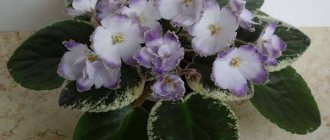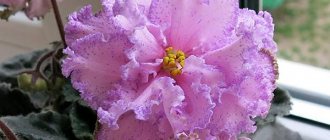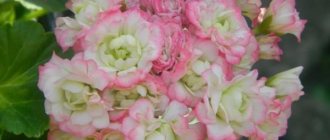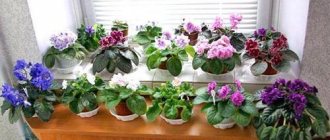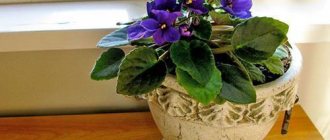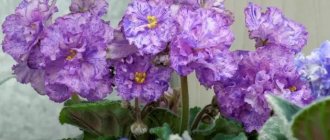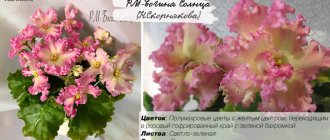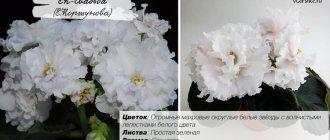With proper care, charming violets delight with lush blooms all year round , and this is the main argument for replenishing your flower collection with several specimens.
Unpretentious to care for, Uzambara violets feel great on window sills in city apartments . But, before growing the YAN-Naryadnaya variety, you definitely need to familiarize yourself with its description and maintenance conditions, so as not to lose the treasured flower due to a minor nuance.
Violet YAN-Naryadnaya (N. Puminova)
Genus, family
Saintpaulia YAN-Naryadnaya (N. Puminova) - Uzambara violet , the flower belongs to the Gesneriev .
History of the variety
In 2010, the YAN-Naryadnaya variety was developed by domestic breeder Natalya Puminova . Natalya is originally from Moscow and began breeding in 1996.
Puminova varieties have the prefix YAN, in honor of the beloved dog - Yanika.
Photo and description
Large double, dark pink stars, closer to crimson in color, with wavy petals and a whitish-greenish border and teeth along the edges. The green tint is clearly visible on the newly opening buds. The flowers of this variety are very elegant and justify the name of the variety.
The first flowering does not always show a clear white border along the edges of the petals ; it is either barely perceptible to the eye or intermittent. Flowering is abundant, the variety reveals its full potential only by the third flowering.
The leaves are quilted, almost dark green, round in shape, jagged at the edges. There are small fibers on top of the leaves, and the underside of the leaves has a red tint. Loves to twist leaves. The size of the outlet is standard, about 25–35 cm in diameter.
With proper care of the violet, the YAN-Elegant rosette forms independently , the Saintpaulia is quite compact, beautiful and symmetrical.
The variety transfers varietal characteristics well from the mother bush to the daughter rosettes.
Reviews
Zhanna Vitalievna. “ The violet “RM-Blue Drifts” has been growing in my collection for the third year now, distinguished by its enchanting flowering, ease of care and very impressive corollas. The petals of the variety have a compacted structure, due to which the double configuration of the flowers is firmly preserved even when the plants are transported to exhibitions.”
Saintpaulia attracts flower growers with its unusual color.
Caring for a plant at home
Caring for Uzambara violet is not difficult . The main thing is to create conditions:
- sufficient humidity;
- lighting;
- monitor watering;
- carry out regular feeding.
Conditions of detention
The variety feels good both on the window and on the rack.
With wick watering it grows leaf mass well. But even with timely overhead watering, the flower develops well.
Proper watering and fertilizing
Water the violet with warm, settled water . Water the violet after the top layer of soil has dried . The soil must be completely wetted, not just the top layer of soil.
Important! The soil should not be allowed to dry out; the delicate root system of the violet will die from lack of moisture.
No earlier than three weeks after transplantation, you need to start fertilizing the new substrate. Fresh soil contains a sufficient supply of necessary microelements for the full development of Uzambara violet.
Feeding begins 3 weeks after transplantation.
Fertilizing is carried out once every two weeks with top watering . If the violet is on wick watering , then fertilizer is added to the water in a lower concentration, but on a regular basis.
Lighting and temperature
The YAN-Nayarnaya variety loves bright lighting. At high growing temperatures, the white border around the edge of the petals may completely disappear, so it is better to grow the variety in cooler conditions.
Air humidity
When the air around violets is humid, they bloom better. Delicate buds react very strongly to dry air , they can dry out or develop very slowly.
In regions with low humidity, wick irrigation is used and the air is additionally humidified.
Advice! To increase air humidity, containers with water are placed, pots with violets are placed in trays with wet pebbles or expanded clay. You can also use special humidifiers.
What soil do you prefer at home?
The soil for growing YAN-Naryadnaya violets should be airy and should not absorb a lot of moisture.
To grow violets you need special soil.
You can buy a ready-made substrate, or you can prepare it yourself.
Soil composition:
- high peat;
- perlite;
- vermiculite;
- sphagnum moss.
Pruning and hygiene
Cut off all asymmetrical, juvenile and old leaves . Pruning of leaves and faded peduncles is carried out with a sharp scalpel or carefully broken off at the stem itself.
Once a month, the violet is given bath treatments . Gently wash off the accumulated dust from the leaves under running warm water. Allow to dry in a warm and dark place, and only then return to its permanent place.
Reproduction methods
The variety is not often planted, but when propagated by leaf cuttings it conveys varietal characteristics well , which is why this method is more popular.
Propagation by leaf cuttings.
Transplant rules, rejuvenation
Young rosettes are replanted as the leaf mass increases and the root system develops . If the rosette has entwined the entire earthen lump, then it is transplanted into a larger pot using the transshipment method. An adult plant is replanted once a year , with partial replacement of the soil.
An adult violet is rejuvenated using the “head removal” method . They cut off the long trunk, remove the excess layer of leaves, trim the trunk like a carrot and plant it in new soil. It is best to put the violet in a greenhouse for two weeks.
Landing place
When choosing containers for planting flowers, you should take into account that specimens planted in identical-sized pots with a diameter and height of 10 cm look impressive. This size is considered optimal. A pot for violets can be made of any material, it does not matter. Both ceramics and plastic are suitable.
A smaller pot size will not allow the plant to develop successfully. However, there are specimens that grow to large sizes, and then they need a larger container.
Features of flowering, growth and reproduction
The flowers remain fresh for quite a long time , during the entire long flowering they retain the brightness of the color of the petals and do not fade.
If agricultural technology is incorrect, if there is insufficient lighting, or vice versa, if there is too much light, the variety begins to twist its leaves .
How long does it take to grow an adult plant?
one and a half months before the babies appear . From the moment the baby is planted until the first flowering of an adult plant, it takes from 9 to 12 months.
Violet YAN-Nayarnaya begins to bloom in 9-12 months.
Advice! If the buds have not yet formed on a mature flower, it is better to remove them. And let the violet grow sufficient leaf mass and become sufficiently strong. For which the violet will thank you with a lush head of flowers.
Flowering in hot and cool conditions
The YAN-Naryadnaya variety may partially or completely lose the white border along the edges of the petals in the heat . Also, with a sharp change in the temperature in the room, the variety can sometimes significantly lighten the flower petals.
In cool conditions, not lower than 18 degrees, the flower feels good, while the white border clearly frames the petals.
If you grow violet “YAN-Naryadnaya” on a windowsill, in winter you need to make sure that the flower does not touch the cold glass . The foliage, in contact with the window, will become supercooled and the variety will freeze, which will negatively affect the growth and development of the plant.
What do flower stalks look like?
The peduncles are long , they can barely withstand abundant cap flowering, sometimes they can lightly fall on the leaves under the weight of large double flowers. Five peduncles produce a beautiful head of flowers, each with about three flowers blooming.
The peduncles of the variety are quite long.
Is it possible to achieve cap flowering?
The first flowering is usually sparse, usually consisting of three to five flowers. A dense cap of flowers appears mainly towards the third flowering.
Bud lifespan
The flowering of each blossoming bud lasts about a month ; for three weeks the color of the blossoming flowers does not change.
Nuances of cultivation
Some gardeners characterize violet as an unpretentious plant, while others cannot cope with caring for the capricious beauty. However, in order to enjoy beautiful flowering, a number of conditions must be observed during the growing process.
The main point is the sunlight, or more precisely, the location of the violets relative to it. Violet Princess Cherry (and all other varieties) loves an abundance of light, but is afraid of direct sunlight.
Thus, north-eastern and north-western windows are the most suitable places for growing violets.
In nature, violets choose places where shrubs can protect them from the bright sun, so you need to try to provide similar conditions indoors. Flower growers often use glass shelves and fluorescent lamps, in which case the violets receive the necessary light and look beautiful.
